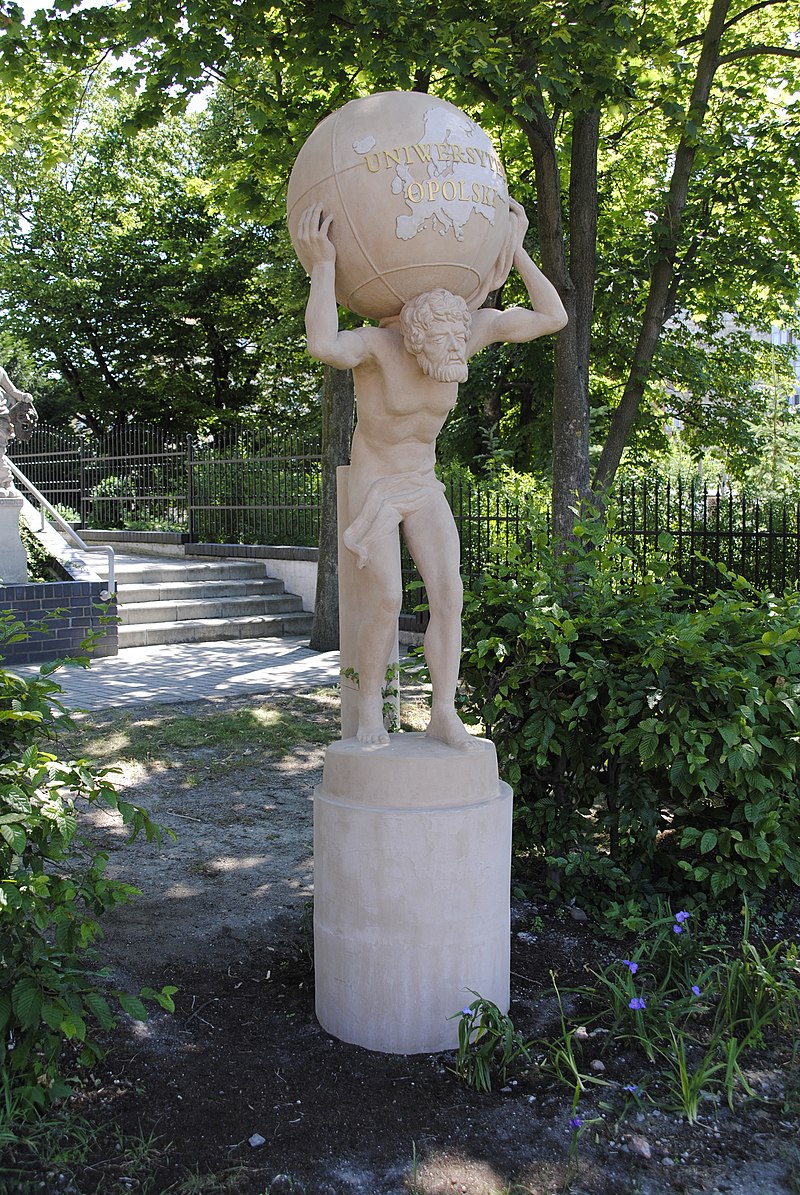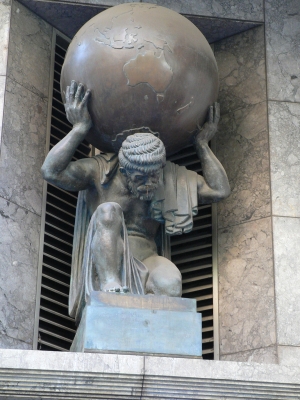The image of the Titan Atlas holding the Earth on his shoulders is an iconic one that has inspired countless writers, thinkers, and artists. It is also a modern notion with no basis whatsoever in any ancient Greek texts. In actual ancient Greek mythology, Atlas does not, in fact, hold the Earth on his shoulders, but rather the sky. The misconception that the ancient Greeks imagined Atlas as holding the Earth on his shoulders arose as a result of the misinterpretation of classical representations of Atlas. In this article, I intend to set the record straight by examining how the ancient Greeks really envisioned Atlas and explaining how the misconception about him holding up the Earth arose.
The modern image of Atlas
The iconic image of Atlas holding up the Earth has had a massive influence in modern popular culture. For instance, a colossal bronze sculpture of Atlas holding the Earth on his shoulders created by the American sculptor Lee Lawrie (lived 1877 – 1963) was installed in front of the Rockefeller Center in Midtown Manhattan in New York City in 1937 and can still be seen there today. This sculpture is often interpreted as personifying the entrepreneurial spirit.
ABOVE: Colossal bronze sculpture by Lee Lawrie depicting Atlas holding the Earth on his shoulders in front of the Rockefeller Center in New York City
The image of Atlas holding the Earth on his shoulders is also notably alluded to in the title of the novel Atlas Shrugged, which was written by the American novelist Ayn Rand (lived 1905 – 1982) and published in 1957 by Random House. Although Atlas Shrugged has been widely panned by reviewers and dismissed by literary critics, it has become something of a cult classic, so it is worth addressing here. The title of the novel is a reference to a conversation in it in which the character Francisco d’Anconia asks the protagonist of the novel Hank Rearden the following question:
“…if you saw Atlas, the giant who holds the world on his shoulders, if you saw that he stood, blood running down his chest, his knees buckling, his arms trembling but still trying to hold the world aloft with the last of his strength, and the greater his effort, the heavier the world bore down on his shoulders—what would you tell him to do?”
Mr. Rearden stammers back, “I… don’t know. What… could he do? What would you tell him?” Francisco replies, “To shrug.”
While Atlas Shrugged is truly a repulsive novel—both by a moral standard and by a literary standard—it is nonetheless an excellent example of the image of Atlas struggling under the weight of the world that has become so prominent in modern popular culture. Indeed, the vivid description given by Francisco of Atlas holding up the Earth with “blood running down his chest, his knees buckling, his arms trembling” may be the most famous modern description of Atlas.

ABOVE: Image of the front cover of the novel Atlas Shrugged by Ayn Rand, which is truly a terrible book, but an excellent example of how the image of Atlas bearing the weight of the world on his shoulders has influenced modern popular culture
Of course, the image of Atlas bearing the weight of the whole world on his shoulders has inspired far more than just the title of a poorly-written 1950s cult classic advocating amoral egoism; it has also given rise to the phrase “Atlas personality,” which is used to describe someone who is forced to take on adult responsibilities at a premature age. Consequently, as an adult, a person with an Atlas personality is unable to avoid burdening themselves with unnecessary responsibilities.
The real Atlas in Greek mythology
Unfortunately, despite the widespread prominence that the idea of Atlas holding up the world in Greek mythology has attained, this notion is an entirely modern one with no basis whatsoever in any classical Greek or Roman sources. The ancient Greeks never envisioned Atlas as holding up the Earth. Instead, they envisioned Atlas as holding up an entirely different celestial object; they envisioned him holding up the sky.
During the Archaic Period (c. 800 – c. 510 BC), the ancient Greeks generally envisioned the Earth as a flat surface and the sky as an enormous dome covering the Earth. They believed that, at all points where the Earth met the dome of the sky, the sky was held up by mountains—except in the far west, where it was held up by the Titan Atlas. The story of why Atlas was sentenced to hold up the sky is long and complicated, but I will give a brief summary of it here.
According to a story from Greek mythology recorded by the eighth-century BC Boiotian poet Hesiodos of Askre in his poem Theogonia, an account of the origins of the gods composed in dactylic hexameter, Atlas was a member of the older generation of gods known as the Titans. The ruler of the Titans was Kronos. Eventually, Kronos’s offspring, led by his youngest son Zeus, rose up to overthrow him. This resulted in a war known as Titanomachia in which Zeus, his siblings, and their allies fought against Kronos and his allies.
All of the Titans were forced to pick sides. Some, such as Atlas’s brothers Prometheus and Epimetheus, sided with Zeus. Others, including Atlas, sided with Kronos. In the end, Zeus and his siblings won the war and defeated the Titans. Zeus proclaimed himself the ruler of the cosmos and issued a dire sentence against Atlas as punishment for having sided with Kronos. Hesiodos describes Atlas’s punishment in lines 517 through 520 of his poem Theogonia. Here is the crucial passage, as translated into English by Hugh G. Evelyn-White:
“And Atlas through hard constraint upholds the wide heaven with unwearying head and arms, standing at the borders of the earth before the clear-voiced Hesperides; for this lot wise Zeus assigned to him.”
In other words, according to Hesiodos, Atlas stands in the far west holding up the sky.

ABOVE: The Fall of the Titans, painted between 1596 and 1598 by the Dutch Golden Age painter Cornelis van Haarlem
During the later Classical Period (c. 510 – c. 323 BC), the Greek realized that the Earth was a sphere. It is unclear exactly who the first person to teach that the Earth was a sphere was. Some ancient authors credit Pythagoras of Samos (lived c. 570 – c. 495 BC) as having been the first, but this attribution seems to have arisen as the result of pseudepigraphical poem that falsely claimed to have been written by Pythagoras. Other ancient sources credit Parmenides of Elea as having been the first to teach the sphericity of the Earth.
In any case, regardless of how the idea came about, by the end of the fifth century BC, virtually anyone in the Greek world who was educated knew that the Earth was a sphere. Consequently, the Greeks began to envision the sky, which they had previously imagined as a dome, as a sphere as well, surrounding the Earth. Thus, in classical depictions of Atlas, he is shown holding the celestial sphere on his shoulders.

ABOVE: Greco-Buddhist relief carving from Hadda, Afghanistan, dating to around 100 AD or thereabouts, depicting Atlas holding up the sky
ABOVE: Farnese Atlas, a second-century AD Roman marble sculpture of Atlas holding up the celestial sphere.
Eventually, however, during the Renaissance, people began to mistake the globe held up by Atlas in classical sculptures for the Earth. Thus, the misconception arose that Atlas was supposed to be holding up the Earth. Eventually, some people began actually portraying Atlas as holding the Earth. For instance, here are some modern sculptures showing Atlas holding the terrestrial globe rather than the celestial one:

ABOVE: Statue showing Atlas holding a globe with Europe on it from Opole, Poland

ABOVE: Statue of Atlas from Melbourne Australia, incorrectly showing him holding the terrestrial globe rather than the celestial one
Conclusion
The ancient Greeks envisioned the Titan Atlas as holding up the sky in the far west as punishment for having sided with Kronos during the Titanomachia. The modern misconception that Atlas was thought to hold up the Earth originates from the misinterpretation of classical sculptures of Atlas depicting him holding the celestial globe. People looked at these sculptures and mistook the globe Atlas is shown holding for the Earth.
Ultimately, myths are stories and stories are allowed to change. If we want to imagine Atlas holding up the Earth for the sake of contemporary portrayals, then we are allowed to do that. We must remember, however, that this is a modern portrayal and that this was never how the ancient Greeks envisioned him.


Fantastic! I had no idea. I’ve certainly learned a lot from your enjoyable and erudite blog, which I’ve been perusing for the past three hours. I would like to suggest that in the statue from the Rockefeller Center, Atlas appears to be holding the heavens rather than the Earth, no? The markings on the circles are from the Zodiac. Or am I misunderstanding the iconography.
Regardless, persevere with your studies. I can tell you are going to be a great boon to academia. (I once was pursuing a PhD in philosophy of science, and have a long-standing though very amateurish hobby in Latin which drew me to your blog.)
From one of your more recent posts, I gather that you feel somewhat frustrated, or at least disadvantaged relative to your peers, by your limited training in classical languages. Please don’t get discouraged. I can confidently state that, for academia, your aptitude for writing and scholarship is far, far more more important than technical proficiencies and prerequisites. You will outstrip most of your peers. The technical skills are important, but less so, and they will come, in time.
I’m from Greece everyone knows that the atlas holds the sky. In The sculptures that you showing in your article we can see clearly that he holds the sky except one but the other ones they have stars and the zodiac circle, how can anyone mistaken that.
Interesting article, but I dont get why the ancient greeks thought there was anything to hold on to in the sky. Why do you think that’s the sky? Maybe he just does handstands sometimes but holds up the Earth with his feet most of the time.
I mean if you flipped a turtle on its back, and took a photo would it be holding the sky with its feet, or the world on its back. This brings to mind that Blade Runner scene.